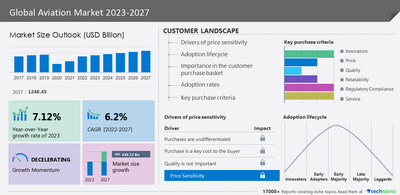NEW YORK, July 27, 2023 /PRNewswire/ — The aviation market is to grow by USD 438.72 billion from 2022 to 2027, However, the market is estimated to decline at a CAGR of 6.2%, according to the latest research report from Technavio. Discover Aerospace & Defense industry potential and make informed business decisions based on qualitative and quantitative evidence highlighted in Technavio reports. View Sample Report!
The aviation market covers the following areas:
Vendor Landscape
The aviation market is fragmented and the vendors are deploying organic and inorganic growth strategies to compete in the market.
Vendors Offerings
- Airbus SE – The company offers aviation services such as Passenger Aircraft.
- DAHER – The company offers aviation services such as aircraft namely Kodiak
- Bombardier Inc. – The company offers aviation services such as Business aircraft.
For the market’s vendor landscape highlights with a comprehensive list of vendors and their offerings – View Sample in a minutes
Key Market Segmentation
This report extensively covers market segmentation by type (commercial aviation, military aviation, and general aviation), revenue stream (passenger and freight), and geography (APAC, Europe, North America, Middle East and Africa, and South America).
- The commercial aircraft segment in the global aviation market is expected to witness significant growth in terms of market revenue when compared. Commercial aircraft serve multiple transportation purposes, including passenger travel, tourism, business travel, and freight transportation. The growth in disposable income among the middle-class population and the rise of low-cost airline companies have positively influenced the number of air passengers, leading to an increased demand for commercial aircraft in the global aviation market. These factors are expected to drive the growth of the commercial aircraft segment in the industry.
View Sample Report in minutes of this report for more highlights into the market segments.
Regional Market Outlook
APAC is estimated to account for 52% of the global growth during the forecast period. The APAC aviation market is projected to experience significant growth in the forecast period. India’s airline industry, for example, is set to expand with orders for over 1,100 aircraft from various domestic airlines in 2023. IndiGo, the country’s largest airline, has approximately 500 aircraft on order, while Air India has placed orders for 470 planes from Airbus and Boeing. This growth is driven by the increasing number of air passengers in the region, especially in emerging economies like India and China, where the middle-class population’s spending is on the rise. The aviation market in APAC benefits from advancements in technology, such as automation and digitalization, which enhance overall efficiency and safety. These factors are expected to boost the growth of the APAC aviation market during the forecast period.
For more key highlights on the regional market share of most of the above-mentioned countries- View Sample Report
Companies Mentioned
- Airbus SE
- BAE Systems Plc
- Bombardier Inc.
- DAHER
- Dassault Aviation SA
- Embraer SA
- General Dynamics Corp.
- General Electric Co.
- Leonardo Spa
- Lockheed Martin Corp.
- Northrop Grumman Systems Corp.
- Pilatus Aircraft Ltd.
- Raytheon Technologies Corp.
- Rolls Royce Holdings Plc
- Saab AB
- Safran SA
- Textron Inc.
- Thales Group
- The Boeing Co.
- United Aircraft Corp.
What’s New? –
- Special coverage on the Russia–Ukraine war; global inflation; recovery analysis from COVID-19; supply chain disruptions, global trade tensions; and risk of recession
- Global competitiveness and key competitor positions
- Market presence across multiple geographical footprints – Strong/Active/Niche/Trivial – Buy the report!
Market Dynamics
Driver-
The increasing efficiency of airlines is a major factor notably driving the market growth. Improved energy efficiency in aircraft is driven by better aircraft utilization, where the average number of passengers and cargo weight per flight has increased, resulting in lower energy consumption per useful service delivered. Fleet renewal also contributes to efficiency improvements. To align with global climate goals, aviation energy efficiency needs to improve by more than 3% per year by 2040, and some infrastructure is already in place to achieve these objectives. Policy measures such as carbon pricing and more stringent efficiency standards will increase the demand for aviation fuel in the coming years. Innovations in wing design can significantly enhance efficiency, reducing fuel costs and pollution. Additionally, flexible navigation systems and real-time updates enable aircraft to avoid unfavorable weather conditions and capitalize on favorable ones. The development of the blended wing body (BWB) is expected to reduce fuel use and emissions. These factors collectively drive the growth of the global aviation market during the forecast period.
Trends
The shift toward radio-frequency identification (RFID) is an emerging trend shaping the market growth. Radio-Frequency Identification (RFID) is a wireless method that utilizes electromagnetic fields to transfer data and track tags attached to objects. In the aviation industry, RFID tags play a crucial role in electronically tracking aircraft. They find extensive applications in the military, aerospace, and retail sectors. Implementing RFID tags can enhance manufacturing efficiency by enabling manufacturers to effectively manage their spare parts inventory. Moreover, these tags offer a means to verify the authenticity of parts during purchase or use. Aircraft maintenance companies leverage this technology to access an aircraft’s complete maintenance history and swiftly identify defective components, resulting in reduced flight delays and cancellations. The adoption of RFID technology is anticipated to have a positive impact on market growth during the forecast period.
Challenge
Complexities in the supply chain due to growing technological advancement are a major challenge hindering market growth. The aviation industry faces challenges due to the coexistence of new aircraft incorporating advanced technologies and older fleets that may not be compatible with modern manufacturing processes and electrical systems. Consequently, upgrading old aircraft becomes more difficult, leading to multiple supply chain challenges concerning aircraft parts and materials. The supply base of the aviation sector struggles to meet the demands of aircraft original equipment manufacturers (OEMs). The introduction of new advanced platforms like B787 MAX, A330neo, A320neo, and Bombardier’s C-Series intensifies the need to integrate advanced technology into existing fleets, increasing pressure on spare part manufacturers and suppliers to ensure timely availability. These complexities in the aviation supply chain resulting from technological advancements can significantly impact the growth of the aviation market during the forecast period.
Gain instant access to 17,000+ market research reports.
Technavio’s SUBSCRIPTION platform
Related Reports:
The commercial aircraft aviation fuel market size is estimated to grow at a CAGR of 7.65% between 2022 and 2027, and the size of the market is forecast to increase by USD 49.5 billion. This report extensively covers market segmentation by application (passenger aircraft and cargo aircraft), type (air turbine fuel (ATF), aviation biofuel, and others), and geography (North America, APAC, Europe, South America, and the Middle East and Africa). The increase in demand for air travel is the key factor driving the growth of the global commercial aircraft aviation fuel market.
Aviation market in the Middle East is projected to grow by USD 6.17 billion with a CAGR of 7.6%, during the forecast period 2021 to 2026. This report extensively covers the aviation market in the Middle East segmentations by type (commercial aircraft, military aircraft, and general aircraft) and geography (Saudi Arabia, United Arab Emirates, Turkey, Israel, and Rest of Middle East). An increase in the number of airports and terminals being constructed is one of the key factors driving the Middle East aviation market growth.
|
Aviation Market Scope |
|
|
Report Coverage |
Details |
|
Base year |
2022 |
|
Historic period |
2017-2021 |
|
Forecast period |
2023-2027 |
|
Growth momentum & CAGR |
Decelerate at a CAGR of 6.2% |
|
Market growth 2023-2027 |
USD 438.72 billion |
|
Market structure |
Fragmented |
|
YoY growth 2022-2023(%) |
7.12 |
|
Regional analysis |
APAC, Europe, North America, Middle East and Africa, and South America |
|
Performing market contribution |
APAC at 52% |
|
Key countries |
US, China, India, UK, and Germany |
|
Competitive landscape |
Leading Vendors, Market Positioning of Vendors, Competitive Strategies, and Industry Risks |
|
Key companies profiled |
Airbus SE, BAE Systems Plc, Bombardier Inc., DAHER, Dassault Aviation SA, Embraer SA, General Dynamics Corp., General Electric Co., Leonardo Spa, Lockheed Martin Corp., Northrop Grumman Systems Corp., Pilatus Aircraft Ltd., Raytheon Technologies Corp., Rolls Royce Holdings Plc, Saab AB, Safran SA, Textron Inc., Thales Group, The Boeing Co., and United Aircraft Corp. |
|
Market dynamics |
Parent market analysis, Market growth inducers and obstacles, Fast-growing and slow-growing segment analysis, COVID-19 impact and recovery analysis and future consumer dynamics, Market condition analysis for the forecast period |
|
Customization purview |
If our report has not included the data that you are looking for, you can reach out to our analysts and get segments customized. |
Key Topics Covered:
1 Executive Summary
- 1.1 Market overview
- Exhibit 01: Executive Summary – Chart on Market Overview
- Exhibit 02: Executive Summary – Data Table on Market Overview
- Exhibit 03: Executive Summary – Chart on Global Market Characteristics
- Exhibit 04: Executive Summary – Chart on Market by Geography
- Exhibit 05: Executive Summary – Chart on Market Segmentation by Type
- Exhibit 06: Executive Summary – Chart on Market Segmentation by Revenue Stream
- Exhibit 07: Executive Summary – Chart on Incremental Growth
- Exhibit 08: Executive Summary – Data Table on Incremental Growth
- Exhibit 09: Executive Summary – Chart on Vendor Market Positioning
2 Market Landscape
- 2.1 Market ecosystem
- Exhibit 10: Parent market
- Exhibit 11: Market Characteristics
3 Market Sizing
- 3.1 Market definition
- Exhibit 12: Offerings of vendors included in the market definition
- 3.2 Market segment analysis
- Exhibit 13: Market segments
- 3.3 Market size 2022
- 3.4 Market outlook: Forecast for 2022-2027
- Exhibit 14: Chart on Global – Market size and forecast 2022-2027 ($ billion)
- Exhibit 15: Data Table on Global – Market size and forecast 2022-2027 ($ billion)
- Exhibit 16: Chart on Global Market: Year-over-year growth 2022-2027 (%)
- Exhibit 17: Data Table on Global Market: Year-over-year growth 2022-2027 (%)
4 Historic Market Size
- 4.1 Global aviation market 2017 – 2021
- Exhibit 18: Historic Market Size – Data Table on global aviation market 2017 – 2021 ($ billion)
- 4.2 Type Segment Analysis 2017 – 2021
- Exhibit 19: Historic Market Size – Type Segment 2017 – 2021 ($ billion)
- 4.3 Revenue Segment Analysis 2017 – 2021
- Exhibit 20: Historic Market Size – Revenue Segment 2017 – 2021 ($ billion)
- 4.4 Geography Segment Analysis 2017 – 2021
- Exhibit 21: Historic Market Size – Geography Segment 2017 – 2021 ($ billion)
- 4.5 Country Segment Analysis 2017 – 2021
- Exhibit 22: Historic Market Size – Country Segment 2017 – 2021 ($ billion)
5 Five Forces Analysis
- 5.1 Five forces summary
- Exhibit 23: Five forces analysis – Comparison between 2022 and 2027
- 5.2 Bargaining power of buyers
- Exhibit 24: Chart on Bargaining power of buyers – Impact of key factors 2022 and 2027
- 5.3 Bargaining power of suppliers
- Exhibit 25: Bargaining power of suppliers – Impact of key factors in 2022 and 2027
- 5.4 Threat of new entrants
- Exhibit 26: Threat of new entrants – Impact of key factors in 2022 and 2027
- 5.5 Threat of substitutes
- Exhibit 27: Threat of substitutes – Impact of key factors in 2022 and 2027
- 5.6 Threat of rivalry
- Exhibit 28: Threat of rivalry – Impact of key factors in 2022 and 2027
- 5.7 Market condition
- Exhibit 29: Chart on Market condition – Five forces 2022 and 2027
6 Market Segmentation by Type
- 6.1 Market segments
- Exhibit 30: Chart on Type – Market share 2022-2027 (%)
- Exhibit 31: Data Table on Type – Market share 2022-2027 (%)
- 6.2 Comparison by Type
- Exhibit 32: Chart on Comparison by Type
- Exhibit 33: Data Table on Comparison by Type
- 6.3 Commercial aviation – Market size and forecast 2022-2027
- Exhibit 34: Chart on Commercial aviation – Market size and forecast 2022-2027 ($ billion)
- Exhibit 35: Data Table on Commercial aviation – Market size and forecast 2022-2027 ($ billion)
- Exhibit 36: Chart on Commercial aviation – Year-over-year growth 2022-2027 (%)
- Exhibit 37: Data Table on Commercial aviation – Year-over-year growth 2022-2027 (%)
- 6.4 Military aviation – Market size and forecast 2022-2027
- Exhibit 38: Chart on Military aviation – Market size and forecast 2022-2027 ($ billion)
- Exhibit 39: Data Table on Military aviation – Market size and forecast 2022-2027 ($ billion)
- Exhibit 40: Chart on Military aviation – Year-over-year growth 2022-2027 (%)
- Exhibit 41: Data Table on Military aviation – Year-over-year growth 2022-2027 (%)
- 6.5 General aviation – Market size and forecast 2022-2027
- Exhibit 42: Chart on General aviation – Market size and forecast 2022-2027 ($ billion)
- Exhibit 43: Data Table on General aviation – Market size and forecast 2022-2027 ($ billion)
- Exhibit 44: Chart on General aviation – Year-over-year growth 2022-2027 (%)
- Exhibit 45: Data Table on General aviation – Year-over-year growth 2022-2027 (%)
- 6.6 Market opportunity by Type
- Exhibit 46: Market opportunity by Type ($ billion)
- Exhibit 47: Data Table on Market opportunity by Type ($ billion)
7 Market Segmentation by Revenue Stream
- 7.1 Market segments
- Exhibit 48: Chart on Revenue Stream – Market share 2022-2027 (%)
- Exhibit 49: Data Table on Revenue Stream – Market share 2022-2027 (%)
- 7.2 Comparison by Revenue Stream
- Exhibit 50: Chart on Comparison by Revenue Stream
- Exhibit 51: Data Table on Comparison by Revenue Stream
- 7.3 Passenger – Market size and forecast 2022-2027
- Exhibit 52: Chart on Passenger – Market size and forecast 2022-2027 ($ billion)
- Exhibit 53: Data Table on Passenger – Market size and forecast 2022-2027 ($ billion)
- Exhibit 54: Chart on Passenger – Year-over-year growth 2022-2027 (%)
- Exhibit 55: Data Table on Passenger – Year-over-year growth 2022-2027 (%)
- 7.4 Freight – Market size and forecast 2022-2027
- Exhibit 56: Chart on Freight – Market size and forecast 2022-2027 ($ billion)
- Exhibit 57: Data Table on Freight – Market size and forecast 2022-2027 ($ billion)
- Exhibit 58: Chart on Freight – Year-over-year growth 2022-2027 (%)
- Exhibit 59: Data Table on Freight – Year-over-year growth 2022-2027 (%)
- 7.5 Market opportunity by Revenue Stream
- Exhibit 60: Market opportunity by Revenue Stream ($ billion)
- Exhibit 61: Data Table on Market opportunity by Revenue Stream ($ billion)
8 Customer Landscape
- 8.1 Customer landscape overview
- Exhibit 62: Analysis of price sensitivity, lifecycle, customer purchase basket, adoption rates, and purchase criteria
9 Geographic Landscape
- 9.1 Geographic segmentation
- Exhibit 63: Chart on Market share by geography 2022-2027 (%)
- Exhibit 64: Data Table on Market share by geography 2022-2027 (%)
- 9.2 Geographic comparison
- Exhibit 65: Chart on Geographic comparison
- Exhibit 66: Data Table on Geographic comparison
- 9.3 APAC – Market size and forecast 2022-2027
- Exhibit 67: Chart on APAC – Market size and forecast 2022-2027 ($ billion)
- Exhibit 68: Data Table on APAC – Market size and forecast 2022-2027 ($ billion)
- Exhibit 69: Chart on APAC – Year-over-year growth 2022-2027 (%)
- Exhibit 70: Data Table on APAC – Year-over-year growth 2022-2027 (%)
- 9.4 Europe – Market size and forecast 2022-2027
- Exhibit 71: Chart on Europe – Market size and forecast 2022-2027 ($ billion)
- Exhibit 72: Data Table on Europe – Market size and forecast 2022-2027 ($ billion)
- Exhibit 73: Chart on Europe – Year-over-year growth 2022-2027 (%)
- Exhibit 74: Data Table on Europe – Year-over-year growth 2022-2027 (%)
- 9.5 North America – Market size and forecast 2022-2027
- Exhibit 75: Chart on North America – Market size and forecast 2022-2027 ($ billion)
- Exhibit 76: Data Table on North America – Market size and forecast 2022-2027 ($ billion)
- Exhibit 77: Chart on North America – Year-over-year growth 2022-2027 (%)
- Exhibit 78: Data Table on North America – Year-over-year growth 2022-2027 (%)
- 9.6 Middle East and Africa – Market size and forecast 2022-2027
- Exhibit 79: Chart on Middle East and Africa – Market size and forecast 2022-2027 ($ billion)
- Exhibit 80: Data Table on Middle East and Africa – Market size and forecast 2022-2027 ($ billion)
- Exhibit 81: Chart on Middle East and Africa – Year-over-year growth 2022-2027 (%)
- Exhibit 82: Data Table on Middle East and Africa – Year-over-year growth 2022-2027 (%)
- 9.7 South America – Market size and forecast 2022-2027
- Exhibit 83: Chart on South America – Market size and forecast 2022-2027 ($ billion)
- Exhibit 84: Data Table on South America – Market size and forecast 2022-2027 ($ billion)
- Exhibit 85: Chart on South America – Year-over-year growth 2022-2027 (%)
- Exhibit 86: Data Table on South America – Year-over-year growth 2022-2027 (%)
- 9.8 US – Market size and forecast 2022-2027
- Exhibit 87: Chart on US – Market size and forecast 2022-2027 ($ billion)
- Exhibit 88: Data Table on US – Market size and forecast 2022-2027 ($ billion)
- Exhibit 89: Chart on US – Year-over-year growth 2022-2027 (%)
- Exhibit 90: Data Table on US – Year-over-year growth 2022-2027 (%)
- 9.9 China – Market size and forecast 2022-2027
- Exhibit 91: Chart on China – Market size and forecast 2022-2027 ($ billion)
- Exhibit 92: Data Table on China – Market size and forecast 2022-2027 ($ billion)
- Exhibit 93: Chart on China – Year-over-year growth 2022-2027 (%)
- Exhibit 94: Data Table on China – Year-over-year growth 2022-2027 (%)
- 9.10 UK – Market size and forecast 2022-2027
- Exhibit 95: Chart on UK – Market size and forecast 2022-2027 ($ billion)
- Exhibit 96: Data Table on UK – Market size and forecast 2022-2027 ($ billion)
- Exhibit 97: Chart on UK – Year-over-year growth 2022-2027 (%)
- Exhibit 98: Data Table on UK – Year-over-year growth 2022-2027 (%)
- 9.11 Germany – Market size and forecast 2022-2027
- Exhibit 99: Chart on Germany – Market size and forecast 2022-2027 ($ billion)
- Exhibit 100: Data Table on Germany – Market size and forecast 2022-2027 ($ billion)
- Exhibit 101: Chart on Germany – Year-over-year growth 2022-2027 (%)
- Exhibit 102: Data Table on Germany – Year-over-year growth 2022-2027 (%)
- 9.12 India – Market size and forecast 2022-2027
- Exhibit 103: Chart on India – Market size and forecast 2022-2027 ($ billion)
- Exhibit 104: Data Table on India – Market size and forecast 2022-2027 ($ billion)
- Exhibit 105: Chart on India – Year-over-year growth 2022-2027 (%)
- Exhibit 106: Data Table on India – Year-over-year growth 2022-2027 (%)
- 9.13 Market opportunity by geography
- Exhibit 107: Market opportunity by geography ($ billion)
- Exhibit 108: Data Tables on Market opportunity by geography ($ billion)
10 Drivers, Challenges, and Trends
- 10.1 Market drivers
- 10.2 Market challenges
- 10.3 Impact of drivers and challenges
- Exhibit 109: Impact of drivers and challenges in 2022 and 2027
- 10.4 Market trends
11 Vendor Landscape
- 11.1 Overview
- 11.2 Vendor landscape
- Exhibit 110: Overview on Criticality of inputs and Factors of differentiation
- 11.3 Landscape disruption
- Exhibit 111: Overview on factors of disruption
- 11.4 Industry risks
- Exhibit 112: Impact of key risks on business
12 Vendor Analysis
- 12.1 Vendors covered
- Exhibit 113: Vendors covered
- 12.2 Market positioning of vendors
- Exhibit 114: Matrix on vendor position and classification
- 12.3 Airbus SE
- Exhibit 115: Airbus SE – Overview
- Exhibit 116: Airbus SE – Business segments
- Exhibit 117: Airbus SE – Key news
- Exhibit 118: Airbus SE – Key offerings
- Exhibit 119: Airbus SE – Segment focus
- 12.4 Bombardier Inc.
- Exhibit 120: Bombardier Inc. – Overview
- Exhibit 121: Bombardier Inc. – Product / Service
- Exhibit 122: Bombardier Inc. – Key offerings
- 12.5 DAHER
- Exhibit 123: DAHER – Overview
- Exhibit 124: DAHER – Product / Service
- Exhibit 125: DAHER – Key offerings
- 12.6 Dassault Aviation SA
- Exhibit 126: Dassault Aviation SA – Overview
- Exhibit 127: Dassault Aviation SA – Product / Service
- Exhibit 128: Dassault Aviation SA – Key offerings
- 12.7 Embraer SA
- Exhibit 129: Embraer SA – Overview
- Exhibit 130: Embraer SA – Business segments
- Exhibit 131: Embraer SA – Key offerings
- Exhibit 132: Embraer SA – Segment focus
- 12.8 General Dynamics Corp.
- Exhibit 133: General Dynamics Corp. – Overview
- Exhibit 134: General Dynamics Corp. – Business segments
- Exhibit 135: General Dynamics Corp. – Key news
- Exhibit 136: General Dynamics Corp. – Key offerings
- Exhibit 137: General Dynamics Corp. – Segment focus
- 12.9 Leonardo Spa
- Exhibit 138: Leonardo Spa – Overview
- Exhibit 139: Leonardo Spa – Business segments
- Exhibit 140: Leonardo Spa – Key news
- Exhibit 141: Leonardo Spa – Key offerings
- Exhibit 142: Leonardo Spa – Segment focus
- 12.10 Lockheed Martin Corp.
- Exhibit 143: Lockheed Martin Corp. – Overview
- Exhibit 144: Lockheed Martin Corp. – Business segments
- Exhibit 145: Lockheed Martin Corp. – Key news
- Exhibit 146: Lockheed Martin Corp. – Key offerings
- Exhibit 147: Lockheed Martin Corp. – Segment focus
- 12.11 Northrop Grumman Systems Corp.
- Exhibit 148: Northrop Grumman Systems Corp. – Overview
- Exhibit 149: Northrop Grumman Systems Corp. – Business segments
- Exhibit 150: Northrop Grumman Systems Corp. – Key news
- Exhibit 151: Northrop Grumman Systems Corp. – Key offerings
- Exhibit 152: Northrop Grumman Systems Corp. – Segment focus
- 12.12 Pilatus Aircraft Ltd.
- Exhibit 153: Pilatus Aircraft Ltd. – Overview
- Exhibit 154: Pilatus Aircraft Ltd. – Product / Service
- Exhibit 155: Pilatus Aircraft Ltd. – Key offerings
- 12.13 Raytheon Technologies Corp.
- Exhibit 156: Raytheon Technologies Corp. – Overview
- Exhibit 157: Raytheon Technologies Corp. – Business segments
- Exhibit 158: Raytheon Technologies Corp. – Key news
- Exhibit 159: Raytheon Technologies Corp. – Key offerings
- Exhibit 160: Raytheon Technologies Corp. – Segment focus
- 12.14 Saab AB
- Exhibit 161: Saab AB – Overview
- Exhibit 162: Saab AB – Business segments
- Exhibit 163: Saab AB – Key news
- Exhibit 164: Saab AB – Key offerings
- Exhibit 165: Saab AB – Segment focus
- 12.15 Textron Inc.
- Exhibit 166: Textron Inc. – Overview
- Exhibit 167: Textron Inc. – Business segments
- Exhibit 168: Textron Inc. – Key news
- Exhibit 169: Textron Inc. – Key offerings
- Exhibit 170: Textron Inc. – Segment focus
- 12.16 Thales Group
- Exhibit 171: Thales Group – Overview
- Exhibit 172: Thales Group – Business segments
- Exhibit 173: Thales Group – Key news
- Exhibit 174: Thales Group – Key offerings
- Exhibit 175: Thales Group – Segment focus
- 12.17 The Boeing Co.
- Exhibit 176: The Boeing Co. – Overview
- Exhibit 177: The Boeing Co. – Business segments
- Exhibit 178: The Boeing Co. – Key offerings
- Exhibit 179: The Boeing Co. – Segment focus
13 Appendix
- 13.1 Scope of the report
- 13.2 Inclusions and exclusions checklist
- Exhibit 180: Inclusions checklist
- Exhibit 181: Exclusions checklist
- 13.3 Currency conversion rates for US$
- Exhibit 182: Currency conversion rates for US$
- 13.4 Research methodology
- Exhibit 183: Research methodology
- Exhibit 184: Validation techniques employed for market sizing
- Exhibit 185: Information sources
- 13.5 List of abbreviations
- Exhibit 186: List of abbreviations
About Us
Technavio is a leading global technology research and advisory company. Their research and analysis focuses on emerging market trends and provides actionable insights to help businesses identify market opportunities and develop effective strategies to optimize their market positions. With over 500 specialized analysts, Technavio’s report library consists of more than 17,000 reports and counting, covering 800 technologies, spanning across 50 countries. Their client base consists of enterprises of all sizes, including more than 100 Fortune 500 companies. This growing client base relies on Technavio’s comprehensive coverage, extensive research, and actionable market insights to identify opportunities in existing and potential markets and assess their competitive positions within changing market scenarios.
Contact
Technavio Research
Jesse Maida
Media & Marketing Executive
US: +1 844 364 1100
UK: +44 203 893 3200
Email: [email protected]
Website: www.technavio.com
![]() View original content to download multimedia:https://www.prnewswire.com/news-releases/aviation-market-by-type-revenue-stream-and-geography–technavio-301886463.html
View original content to download multimedia:https://www.prnewswire.com/news-releases/aviation-market-by-type-revenue-stream-and-geography–technavio-301886463.html
SOURCE Technavio

Featured image: Megapixl © Starletdarlene
















